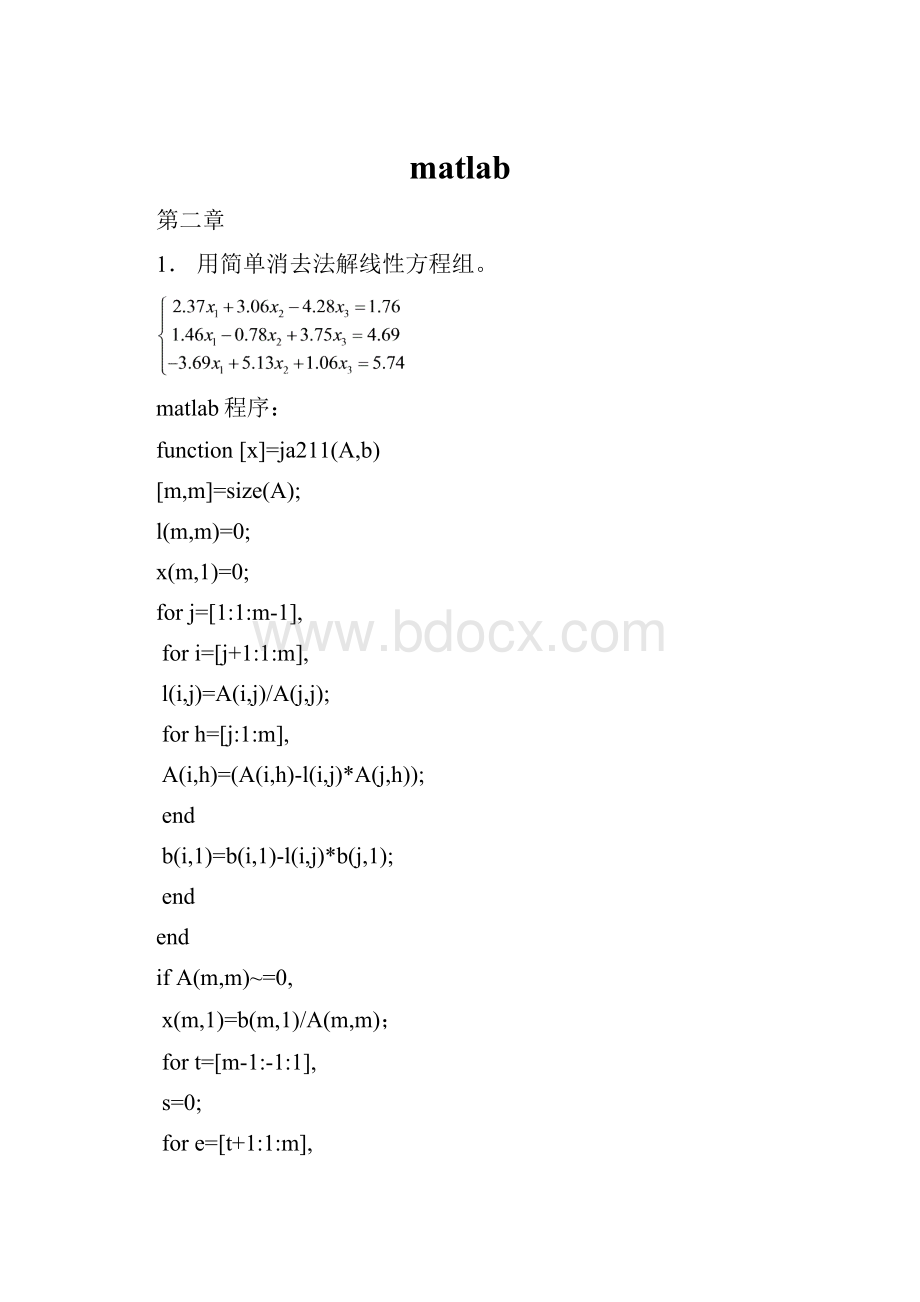matlab.docx
《matlab.docx》由会员分享,可在线阅读,更多相关《matlab.docx(22页珍藏版)》请在冰豆网上搜索。

matlab
第二章
1.用简单消去法解线性方程组。
matlab程序:
function[x]=ja211(A,b)
[m,m]=size(A);
l(m,m)=0;
x(m,1)=0;
forj=[1:
1:
m-1],
fori=[j+1:
1:
m],
l(i,j)=A(i,j)/A(j,j);
forh=[j:
1:
m],
A(i,h)=(A(i,h)-l(i,j)*A(j,h));
end
b(i,1)=b(i,1)-l(i,j)*b(j,1);
end
end
ifA(m,m)~=0,
x(m,1)=b(m,1)/A(m,m);
fort=[m-1:
-1:
1],
s=0;
fore=[t+1:
1:
m],
s=s+A(t,e)*x(e,1),
end
x(t,1)=(b(t,1)-s)/A(t,t),
end
end
题解
C=[2.373.06-4.28;1.46-0.783.75;-3.695.131.06;];
>>d=[1.76;4.69;5.74;];
>>ja211(C,d)
ans=
0.933798514091890
1.541054685145016
1.207647153023721
2.用主元消去法解线性方程组。
Matlab程序:
function[x]=ja221(A,b)
[m,m]=size(A);
D(1,m)=0;
l(m,m)=0;
x(m,1)=0;
forj=[1:
1:
m-1],
c=find(A(j:
1:
m,j)==max(A(j:
1:
m,j)));
D=A(j,:
);d=b(j,1);
A(j,:
)=A(c+j-1,:
);b(j,1)=b(c+j-1,1);
A(c+j-1,:
)=D;b(c+j-1,1)=d;
fori=[j+1:
1:
m],
l(i,j)=A(i,j)/A(j,j);
forh=[j:
1:
m],
A(i,h)=(A(i,h)-l(i,j)*A(j,h));
end
b(i,1)=b(i,1)-l(i,j)*b(j,1);
end
end
ifA(m,m)~=0,
x(m,1)=b(m,1)/A(m,m);
fort=[m-1:
-1:
1],
s=0;
fore=[t+1:
1:
m],
s=s+A(t,e)*x(e,1);
end
x(t,1)=(b(t,1)-s)/A(t,t);
end
end
题解
A=[10.83240.76750.9831;0.83240.69300.64000.8190;...
0.76750.64000.59110.7580;0.98310.81900.75800.0055;];
>>b=[8.8997;7.4144;6.8528;4.9171;];
>>ja221(A,b)
ans=
0.999999999999273
2.000000000000864
3.000000000000011
4.00000000000000
5.用LU分解法求线性方程组。
Matlab程序:
function[LUx]=ja51(A,b)
[n,n]=size(A);
L=eye(size(A));
U=zeros(size(A));
U(1,:
)=A(1,:
);
fori=[2:
1:
n],
forj=[1:
1:
n],
ifjs1=0;
fore1=[1:
1:
j-1],
s1=s1+L(i,e1)*U(e1,j);
end
L(i,j)=(A(i,j)-s1)/U(j,j);
elseifj>=i,
s2=0;
fore2=[1:
1:
i-1],
s2=s2+L(i,e2)*U(e2,j);
end
U(i,j)=A(i,j)-s2;
end
end
end
y(n,1)=0;
x(n,1)=0;
forh=[1:
1:
n],
ifh==1,
y(h,1)=b(1,1);
else
s3=0;
fore3=[1:
1:
h-1],
s3=s3+L(h,e3)*y(e3,1);
end
y(h,1)=b(h,1)-s3;
end
end
fort=[n:
-1:
1],
ift==n,
x(t,1)=y(n,1)/U(n,n);
else
s4=0;
fore4=[t+1:
1:
n],
s4=s4+U(t,e4)*x(e4,1);
end
x(t,1)=(y(t,1)-s4)/U(t,t);
end
end
题解:
(1)
>>A=[201;-34-2;17-5;];
>>b=[4;-3;6;];
>>[LUx]=ja51(A,b)
L=
1.00000000000000000
-1.5000000000000001.0000000000000000
0.5000000000000001.7500000000000001.000000000000000
U=
2.00000000000000001.000000000000000
04.000000000000000-0.500000000000000
00-4.625000000000000
x=
1.864864864864865
0.783783783783784
0.270270270270270
(2)
AA=[10.17-0.250.54;0.4710.67-0.32;...
-0.110.351-0.74;0.550.430.361;];
>>bb=[0.3;0.5;0.7;0.9;];
>>[LUx]=ja51(AA,bb)
L=
Columns1through3
1.00000000000000000
0.4700000000000001.0000000000000000
-0.1100000000000000.4007173133355071.000000000000000
0.5500000000000000.3657211172698620.318896973426907
Column4
0
0
0
1.000000000000000
U=
Columns1through3
1.0000000000000000.170000000000000-0.250000000000000
00.9201000000000000.787500000000000
000.656935115748288
000
Column4
0.540000000000000
-0.573800000000000
-0.450668405608086
.0565********
x=
0.440888550891832
-0.363030990136447
1.166********5979
0.393567223148812
6.设对称正定矩阵
能作分解
,其中
为下三角矩阵,
为
的转置矩阵,试推导
的元素
可由下列公式确定:
8.作矩阵的
分解(用五位小数计算)。
Matlab程序:
function[LD]=ja28(A,b)
[n,n]=size(A);
L=eye(size(A));
D=zeros(size(A));
fori=[2:
1:
n],
A(i,1)=A(i,1)/A(1,1);
forj=[2:
1:
n],
ifi>j;
s1=0;
fore1=[1:
1:
j-1],
s1=s1+A(e1,e1)*A(i,e1)*A(j,e1);
end
A(i,j)=(A(i,j)-s1)/A(j,j);
elseifi==j,
s2=0;
fore2=[1:
1:
i-1],
s2=s2+A(e2,e2)*A(i,e2)*A(i,e2);
end
A(i,j)=A(i,j)-s2;
end
end
end
forh=[1:
1:
n],
D(h,h)=A(h,h);
end
fork=[2:
1:
n],
fort=[1:
1:
k-1],
L(k,t)=A(k,t);
end
end
题解:
>>A=[10.83240.76750.9831;0.83240.69300.64000.8190;...
0.76750.64000.59110.7580;0.98310.81900.75800.0055;];
>>[LD]=ja28(A,b)
L=
Columns1through3
1.00000000000000000
0.8324000000000001.0000000000000000
0.76750000000000010.2775761973946751.000000000000000
0.9831000000000006.0555152394805460.353113136417216
Column4
0
0
0
1.000000000000000
D=
Columns1through3
1.00000000000000000
00.0001102400000000
00-0.009600743831649
000
Column4
0
0
0
-0.963830923689467
9.分别用
分解法和
分解法求解线性方程组。
Matlab
求解程序:
function[LDx]=ja2911(A,b)
[n,n]=size(A);
L=eye(size(A));
D=zeros(size(A));
fori=[2:
1:
n],
A(i,1)=A(i,1)/A(1,1);
forj=[2:
1:
n],
ifi>j;
s1=0;
fore1=[1:
1:
j-1],
s1=s1+A(e1,e1)*A(i,e1)*A(j,e1);
end
A(i,j)=(A(i,j)-s1)/A(j,j);
elseifi==j,
s2=0;
fore2=[1:
1:
i-1],
s2=s2+A(e2,e2)*A(i,e2)*A(i,e2);
end
A(i,j)=A(i,j)-s2;
end
end
end
forh=[1:
1:
n],
D(h,h)=A(h,h);
end
fork=[2:
1:
n],
fort=[1:
1:
k-1],
L(k,t)=A(k,t);
end
end
y(n,1)=0;
x(n,1)=0;
y(1,1)=b(1,1)/D(1,1);
fora=[2:
1:
n],
s3=0;
fore3=[1:
1:
a-1],
s3=s3+L(a,e3)*D(e3,e3)*y(e3,1);
end
y(a,1)=(b(a,1)-s3)/D(a,a);
end
x(n,1)=y(n,1);
forbb=[n-1:
-1:
1],
s4=0;
fore4=[bb+1:
1:
n],
s4=s4+L(e4,bb)*x(e4,1);
end
x(bb,1)=y(bb,1)-s4;
end
题解:
(1)
A=[4-2-4;-21710;-4109;];
>>b=[10;3;-7;];
>>[LDx]=ja2911(A,b)
L=
1.00000000000000000
-0.5000000000000001.0000000000000000
-1.0000000000000000.5000000000000001.000000000000000
D=
400
0160
001
x=
2
1
-1
(2)
>>A=[10.83240.76750.9831;0.83240.69300.64000.8190;...
0.76750.64000.59110.7580;0.98310.81900.75800.0055;];
>>b=[8.8997;7.4144;6.8528;4.9171;];
>>[LDx]=ja2911(A,b)
L=
Columns1through3
1.00000000000000000
0.8324000000000001.0000000000000000
0.76750000000000010.2775761973946751.000000000000000
0.9831000000000006.0555152394805460.353113136417216
Column4
0
0
0
1.000000000000000
D=
Columns1through3
1.00000000000000000
00.0001102400000000
00-0.009600743831649
000
Column4
0
0
0
-0.963830923689467
x=
0.999999999999501
2.000000000000462
3.000000000000151
3.999999999999999
用
编程求解程序:
function[Lx]=ll(A,b)
[n,m]=size(A);
L=zeros(size(A));
L(1,1)=(A(1,1))^(1/2);
fori=[2:
1:
n],
forj=[1:
1:
i],
ifjs1=0;
fore1=[1:
1:
j-1],
s1=s1+L(i,e1)*L(j,e1);
end
L(i,j)=(A(i,j)-s1)/L(j,j);
elsej>=i,
s2=0;
fore2=[1:
1:
i-1],
s2=s2+L(i,e2)*L(i,e2);
end
L(i,j)=(A(i,i)-s2)^(1/2);
end
end
end
y(n,1)=0;
x(n,1)=0;
fork=[1:
1:
n],
s3=0;
fore3=[1:
1:
k-1],
s3=s3+L(k,e3)*y(e3,1);
end
y(k,1)=(b(k,1)-s3)/L(k,k);
end
x(n,1)=y(n,1);
forh=[n-1:
-1:
1],
s4=0;
fore4=[h+1:
1:
n],
s4=s4+L(e4,h)*x(e4,1);
end
x(h,1)=(y(h,1)-s4)/L(h,h);
end
题解:
(1)
A=[4-2-4;-21710;-4109;];
b=[10;3;-7;];
[Lx]=ll(A,b)
L=
200
-140
-221
x=
2
1
-1
(2)
A=[10.83240.76750.9831;0.83240.69300.64000.8190;...
0.76750.64000.59110.7580;0.98310.81900.75800.0055;];
>>b=[8.8997;7.4144;6.8528;4.9171;];
>>[Lx]=ll(A,b)
L=
Column1
1.000000000000000
0.832400000000000
0.767500000000000
0.983100000000000
Column2
0
0.010499523798722
0.107909655877723
0.063580026370449
Column3
0
0
0.000000000000000+0.097983385487789i
-0.000000000000000+0.034599220566370i
Column4
0
0
0
0.000000000000000+0.981748910714683i
x=
-4.230492466831677+5.135030281812863i
11.705472294606809-9.528336853201315i
4.412452545669016-1.386673748146589i
-0.000000000000000+3.926995642858731i
10.用简单迭代法解下列线性方程组。
(按三位小数进行计算)
Matlab程序:
functionx1=jacobi(A,b,x0,N,E)
[m,n]=size(A);
x(m,2)=0;
x(:
2)=x0;
fori=[1:
1:
N],
ifmax(abs(x(:
1)-x(:
2)))break;
else
x(:
1)=x(:
2);
forj=[1:
1:
n],
s1=0;
fore1=[1:
1:
n],
s1=s1+A(j,e1)*x(e1,1);
end
x(j,2)=(b(j,1)-s1+A(j,j)*x(j,1))/A(j,j);
end
end
end
x1=x(:
2);
题解:
(1)
AA=[276-1;6152;11-2;];
>>bb=[85;72;110;];
>>x0=[1;1;1;];
>>jacobi(AA,bb,x0,100,0.0001)
ans=
-1.351465849800266
11.966245114666920
-49.692619548641581
(2)
>>A=[81-2;3101;5-220;];
>>b=[9;19;72;];
>>x0=[1;1;1;];
>>jacobi(A,b,x0,100,0.0001)
ans=
1.808733564833984
1.032266759707031
3.251038359500000
13.用简单迭代法、塞德尔迭代法解线性方程组(个迭代五次)。
并与精确解
比较。
Matlab程序:
functionx1=GS(A,b,x0,N,E)
[m,n]=size(A);
x(m,2)=0;
x(:
2)=x0;
fori=[1:
1:
N],
ifmax(abs(x(:
1)-x(:
2)))break;
else
x(:
1)=x(:
2);
forj=[1:
1:
n],
ifj==1,
s1=0;
fore1=[2:
1:
m],
s1=s1+A(1,e1)*x(e1,1);
end
x(j,2)=(b(1,1)-s1)/A(1,1);
elseifj==m,
s2=0;
fore2=[1:
1:
m-1],
s2=s2+A(m,e2)*x(e2,2);
end
x(j,2)=(b(m,1)-s2)/A(m,m);
else
s3=0;
fore3=[1:
1:
j-1],
s3=s3+A(j,e3)*x(e3,2);
end
fore4=[j+1:
1:
m],
s3=s3+A(j,e4)*x(e4,1);
end
x(j,2)=(b(j,1)-s3)/A(j,j);
end
end
end
end
x1=x(:
2);
题解:
A=[5-1-1-1;-110-1-1;-1-15-1;-1-1-110;];
b=[-4;12;8;34;];
>>x0=[1;1;1;1];
>>jacobi(A,b,x0,5,0.000001)
ans=
0.968000000000000
1.981270000000000
2.968640000000000
3.981290000000000
>>GS(A,b,x0,5,0.000001)
ans=
0.996552514803221
1.998599188612620
2.998420412137192
3.999357211555304
与真实值比较最大误差是0.004